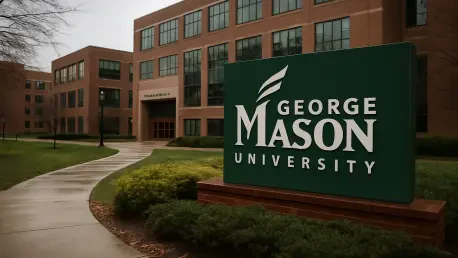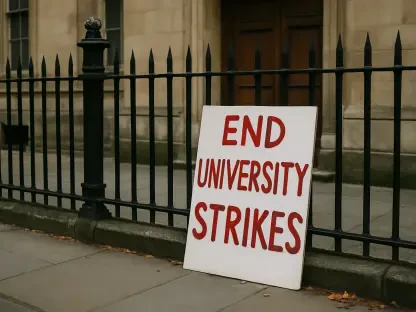Imagine a public university near the nation’s capital, renowned for its academic rigor, suddenly thrust into the national spotlight over allegations of civil rights violations. George Mason University (GMU), located just outside Washington, D.C., finds itself at the heart of a heated controversy surrounding its diversity, equity, and inclusion (DEI) policies. Accused by federal authorities of discriminating through hiring and promotion practices, GMU’s case has ignited a broader debate about the balance between equity initiatives and anti-discrimination laws. This roundup gathers insights, critiques, and recommendations from various stakeholders in higher education, legal fields, and academic advocacy to explore whether such policies violate civil rights law or represent a necessary push toward inclusivity.
Diving into the Allegations: What Federal Authorities Claim
The U.S. Department of Education’s Office for Civil Rights (OCR) has leveled serious accusations against GMU, asserting that its DEI strategies contravene Title VI of the Civil Rights Act, which prohibits discrimination in federally funded programs. According to federal investigators, specific university policies—such as prioritizing diversity in hiring and bypassing competitive searches for candidates who enhance demographic representation—demonstrate an unlawful preference for certain racial groups. This perspective holds that such actions, regardless of intent, undermine equal treatment under the law.
A significant point of contention is the interpretation of statements and policies from GMU’s leadership over recent years. Federal authorities argue that directives to align faculty demographics with a diverse student body inherently favor specific racial or ethnic groups, creating a system where merit may be secondary to identity. This stance reflects a broader policy shift under current federal leadership, emphasizing strict adherence to anti-discrimination statutes over equity-driven reforms in higher education.
Contrasting opinions from legal analysts suggest that the OCR’s approach might oversimplify complex social goals. Some experts in civil rights law argue that addressing systemic inequities often requires intentional measures, and labeling these as discriminatory could set a precedent that stifles institutional efforts to rectify historical imbalances. This divide underscores a critical question: where does the line fall between lawful equity and unlawful bias?
GMU’s Stance: Defending Diversity Without Discrimination
From the university’s perspective, there is no evidence of racial preference in its policies, only a commitment to fostering an inclusive environment. GMU’s leadership has publicly maintained that their DEI initiatives aim to address underrepresentation without resorting to quotas or explicit favoritism. They contend that federal interpretations of Title VI have shifted dramatically, reframing long-standing equity efforts as violations in a way that misrepresents their purpose.
Further insights from university administrators highlight a practical challenge: revising policies under federal pressure could risk alienating faculty and students who see DEI as integral to campus culture. There is also concern about the potential loss of federal funding if a resolution agreement—demanding policy changes and an apology—is rejected. This delicate balance between compliance and conviction shapes GMU’s ongoing response to the allegations.
Academic governance bodies within GMU have also weighed in, emphasizing the importance of institutional autonomy. Many argue that federal mandates, if accepted without contest, could erode the university’s ability to shape its own mission. This viewpoint reveals an underlying tension between external oversight and internal values, a theme resonating across multiple institutions facing similar scrutiny.
Broader Federal Oversight: A Pattern of Scrutiny in Higher Education
Beyond GMU, federal investigations into DEI programs have become a recurring theme under the current administration, targeting numerous universities for perceived discrimination. Insights from policy analysts suggest that this wave of probes, extending to admissions practices and campus responses to issues like antisemitism, reflects a deliberate effort to redefine how civil rights laws are enforced. The approach prioritizes colorblind policies over targeted equity measures, sparking debate over its long-term impact.
Observations from higher education associations point to a potential chilling effect on diversity initiatives. Many institutions may scale back programs out of fear of legal repercussions, even if they believe such efforts align with their educational missions. This concern raises questions about whether federal actions genuinely protect civil rights or inadvertently hinder progress toward inclusive academic spaces.
Legal scholars offer a nuanced take, noting that while anti-discrimination laws are vital, their application must consider context. Some argue that a rigid interpretation risks ignoring systemic barriers that DEI policies aim to dismantle, potentially widening disparities in representation. This perspective calls for a more flexible framework that balances legal compliance with social progress, a balance yet to be struck in federal policy.
Academic Freedom at Stake: Concerns from Faculty and Advocates
Voices from faculty advocacy groups express alarm over what they see as federal overreach into academic affairs. Representatives from organizations supporting university professors argue that investigations into GMU and similar institutions threaten shared governance and free expression. They contend that targeting faculty bodies for supporting DEI initiatives could suppress open dialogue on critical social issues.
Additional perspectives from campus communities highlight a broader fear: that federal interventions might deter universities from pursuing innovative equity programs. Faculty members across various institutions worry that the pressure to conform to strict interpretations of law could limit their ability to address unique student needs, ultimately reshaping the academic landscape in unintended ways.
A contrasting opinion from some policy watchers suggests that federal scrutiny serves as a necessary check on unchecked institutional power. They argue that without oversight, universities might prioritize ideological goals over fairness, potentially alienating segments of their communities. This viewpoint, though less prevalent among academic circles, adds depth to the ongoing discourse about the role of external regulation in higher education.
Navigating the Divide: Tips for Universities Under Scrutiny
Drawing from legal and academic consultants, one key recommendation for universities like GMU is to maintain transparent documentation of DEI policies. Clear records demonstrating intent and implementation can serve as a defense against allegations of discrimination, ensuring that initiatives are framed as inclusive rather than preferential. This proactive step could help institutions navigate federal reviews with greater confidence.
Another tip from higher education advisors is to engage legal counsel early when designing equity programs. Anticipating potential conflicts with civil rights law allows universities to craft policies that withstand scrutiny while still advancing diversity goals. This approach emphasizes preparation over reaction, a strategy gaining traction among institutions facing similar challenges.
Finally, insights from policy experts suggest fostering dialogue with federal agencies before conflicts escalate. Open communication about the purpose and impact of DEI initiatives might mitigate misunderstandings, creating space for compromise rather than confrontation. Such collaboration could pave the way for clearer guidelines that benefit both universities and regulators in addressing equity lawfully.
Reflecting on the Discourse: Key Takeaways and Next Steps
Looking back on this roundup, the debate surrounding GMU’s DEI policies encapsulates a profound national struggle over the intersection of civil rights and equity in higher education. Diverse perspectives—from federal authorities and university leaders to faculty advocates and legal analysts—reveal a spectrum of thought on whether such initiatives violate anti-discrimination laws or serve as essential tools for inclusion. The tension between strict legal interpretations and the pursuit of systemic change stands out as a defining theme.
Moving forward, stakeholders in academia should consider advocating for updated federal guidance that clarifies how Title VI applies to modern diversity efforts. Universities might also explore forming coalitions to share best practices for balancing compliance with mission-driven goals. For educators, students, and policymakers, delving into case studies of institutions under scrutiny offers valuable lessons on navigating this complex landscape, ensuring that the pursuit of equity remains both lawful and impactful.









